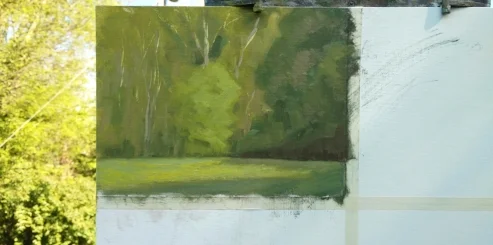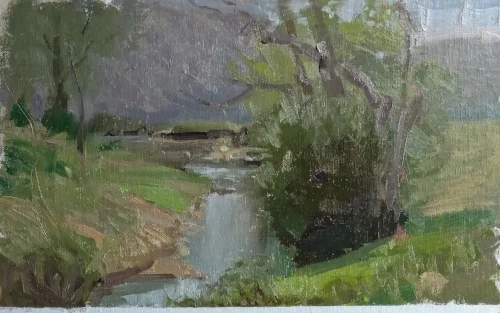Scott Christensen in Tennessee
(I will be adding a review of the show at the Booth Western Art Museum featuring Scott and Quang Ho where I attempt to point out some of the lessons that I learned from this workshop in action in both of their paintings).
Pre-workshop house cleaning
What is there to say?
When someone who knows what they are talking about is speaking, you listen. I went into the workshop with an open mind. I had determined that I was not going to be there to show him how I paint or to practice what I already did. I was going to be open to criticism and ready to practice what he said to practice with materials that he recommended.
I did not want to arrive with obvious problems I knew I had to correct, but I didn't have time to work on them all. So, I chose one problem to tackle before the workshop started. In the two or so weeks before the start date, I went out when I could to practice painting brightness. I painted too dark, and I knew it. High-contrast scenes make me uncomfortable. I didn't make good paintings, but just being focused on a single thing helped me not worry so much. I knew what I was after, and I pursued it.
The Beginning
I always arrive early. Perhaps because I live an hour away from the workshop location, Leiper's Fork, Tennessee, I leave early to guard against snags. Really, though, I arrive early to work out jitters. I find a spot and make a small sketch - just move paint around, breathe deep, and remember that I know how to hold a brush. When I am excited to paint I almost always do poorly. Something about the excitement interferes with my process (as if I have one). It's one reason I do more looking than painting. So, I found a spot with strong light and shadow and sketched. Nothing but light and shadow. No changing the world here.
Day one first sketch. Jitters dealt with.
One wall at Leiper's Creek Gallery.
Green's Grocery.
Leiper's Creek Gallery was our point of departure for the two-minute drive down to the workshop location. Google it. It’s beautiful, and the owner is so, so nice.
The day started inside Green's Grocery. Look it up if you can. It's neat. I didn't know that folks could rent it for events. I thought it was just a closed up old store. Surprise!
Green's Grocery Closeup
REPEAT
Scott showed image after image of works that inspired him for one reason or another. This artist for trees, this person for brushwork, this one for design, colorful shadows, drawing, etc... each day would begin like this.
Imagine being inside his mind while he is studying and researching material for something he is working on or plans to begin. That’s what we got the first half of each day. After lunch, we’d find a spot, disperse, and wait for him to come around.
I only know what he said to me. We would gather at the end to review what each had done, but I only remember what his direction for me was. I found that he practices all of the elements all the time, but I could only focus on a couple.
He would have all image making elements in mind from the beginning. Composition, value structure, main idea, etc. I have to think about these things as the become problems, but I’m working on it.
My takeaways from the workshop
Know why you are selecting a scene. Otherwise, what are you doing?
Leave dots and dashes “randomly” to add interest. He calls them “ticks”.
Don’t be afraid to place some darks in the distance.
Don’t be afraid to depart from the scene.
Break the line. Don’t have continuous, unbroken lines.
Vary sizes and proportions.
Increase saturation in reflected light.
Don’t try to fix everything. Leave it. Put it down and leave it alone.
Top left is my day one morning jitter reducer. The next two are my lunch break sketches (see him work on them HERE). The bottom right is from a later day and another painting (I ended up painting it - see Home page).
Sketch one. All mine, but he boosted the saturation in the trunks (reflected light) and added a couple of dark marks to the base of the trees. Mid-afternoon light from directly above (pretty much).
(Much glare on image. Use your imagination!) Light Changes as rain moves in. I left the background tree mass too light and the right side undone, but didn't worry about it. Scott again added dark marks (a theme was developing...) You may notice a dark circular mark in the middle of the main mass - that is his check on value. He would place a dark up in the branches, back on the distant bank, and a greener dark at the base of the small tree in the back left corner. Also, though the water was shallow and rippled, he suggested pulling it downward to say "water."
Well, this is from the last day of the workshop. I was trying to incorporate small dark marks, but also colorful reflected light, composition, departure from the scene...gosh, all of it. I did alright for parts. I departed from the scene in front of me by selecting and exaggerating the treeline, fence, and distant hills. That's a win.
However, he again placed stronger color in the light on the tree (can't tell it here) and in the dark bottom of the fence. He placed small dark marks (stronger than I had) at the tree base and two really important ones in the fence. Really Important. The dark vertical in the middle of the fence and the dark horizontal on the left edge heading out of the picture. After he put those marks in and placed three light marks (over the last dark on left edge, then to the right of that mark, and a horizontal light at top of fence) the whole fence read right - not as the scene gave, but as the painting needed. The fence read without being a distraction or a dark mass (as I had it).








